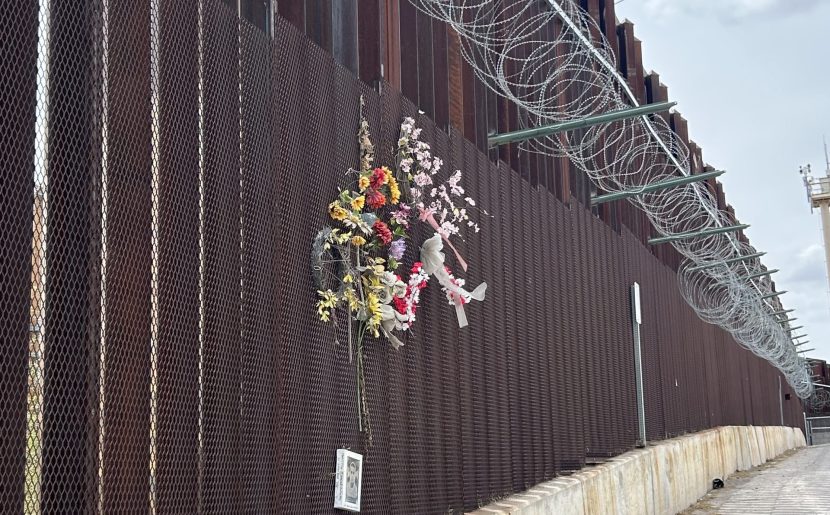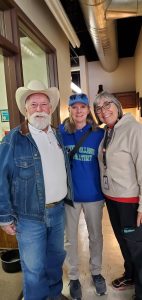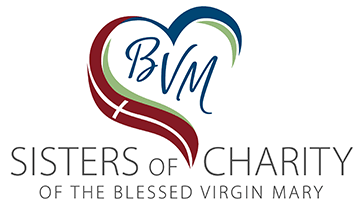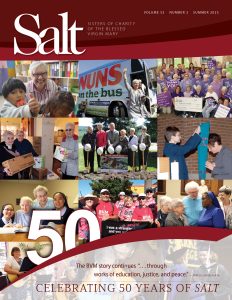Reflections at the Border: BVM Sisters Journey to Nogales


by Katie Anders, BVM and Colleen McGinnity, BVM
On a Heritage Tour to visit BVM missions in the West, novice Katie Anders and Colleen McGinnity, BVM made a stop to visit the border in Nogales, Ariz. Salt invites you to journey with them as they share their emotional reactions to thoughts about what they witnessed, reflecting on the challenges, struggles, and human stories tied to the border experience.
 Called to Welcome the Stranger
Called to Welcome the Stranger
by Katie Anders, BVM
On April 3, Colleen and I travelled from Phoenix to Nogales, Ariz., to learn more about immigration. Upon arriving, we met with Mobilization Specialist Sister Eileen McKenzie, FSPA and Mission Engagement Officer Father Pete Neeley, SJ who introduced us to the work of the Kino Border Initiative.
This is a non-profit organization that works on both sides of the border assisting migrants. Their vision is migration with dignity, and their mission is to promote humane, just, and workable migration through direct humanitarian assistance, holistic accompaniment of migrants, and policy advocacy in both Mexico and the United States.
Eileen walked with us to one of the three ports of entry along Nogales’ border to get a sense of the fluidity of movement into and out of both countries.
People were walking and driving, going to work, going to school, visiting family and friends, attending church services, and doing their shopping. It has become such a violent system for the migrants as well as for the border patrol with the wall and barbed wire as a constant reminder, and yet there was a sense of normalcy in the rhythm of what was happening.
Eileen commented several times that part of the work they do through education, advocacy, and encounter is to help change the narrative that is given to us through the media. Sadly, migration has come to be criminalized in our perceptions, but the vast majority of the people trying to migrate are simply seeking a safe and healthy life. Yet, nothing about their journey is simple.
As we walked along the wall together, the scene I will carry with me was a family celebrating a birthday on both sides of the wall. A young couple on the U.S. side and the rest of their family on the Mexico side. The young man was cooking on the tailgate of his pick-up, and the woman was reaching her fingers through the grate that has been placed over the slats of the fence, trying to touch a small baby that a woman was holding on her lap on the other side.
It was a family picnic like nothing I have ever seen. They were smiling and laughing together, and while I too smiled with them as we passed by, my heart also ached as I’m sure theirs did, too.
This experience reminded me not only about what a complicated issue immigration is, but after spending time with Eileen walking the wall, I experienced in a new way how we are called to welcome the stranger and that this can be done with dignity, compassion, and joy.

A Country of Immigrants
by Colleen McGinnity, BVM
Nogales, Ariz,. is a small city of 20,000 that literally spans the U.S./Mexico border. On the other side of the wall is the much larger Nogales, Sonora, Mexico, a city of nearly 265,000.
The border patrol refers to the wall as a fence. It reaches 13’ into the air. The slats are 4-5” apart, big enough for a hand to reach through and touch hands on the other side. At the beginning this was possible, but no longer. Today, the fence is covered by chicken wire, making it impossible to reach across.
Along the top of the wall are huge rolls of razor wire that extend about a yard away from the slats and would cut to pieces anything, or anyone, that touches it. For much of the wall, the wire is at both the top and the bottom. It is a cruel, ugly statement of “You are not welcome here! We do not want you!”
The wall filled me with shame and left me wondering “Who are we as a people, as a country?” We are a country of immigrants from our very beginning.
Eileen has worked with the Kino Initiative for a year and a half. She is a welcoming woman, whose wide smile expresses warmth, acceptance, and a bit of mischief.
She crosses into Mexico several times a week. Because so few BVM immigrants are coming into the United States today, much of the work of Kino is in Mexico, supporting the people being detained. The Kino Initiative operates on both sides of the border. Kino USA has a large corps of volunteers who help collect and sort donated items.
Eileen said that some people share the views of the American government. However, most residents of Nogales do not share the animosity expressed by U.S. leaders. Nor do they experience the behavior of the immigrants as described by American authorities—cruelty, violence, and rape. Eileen feels safe in the city, but admits that, as a woman, she does not usually go out alone at night.
She shared with us that the border became a problem after the NAFTA trade agreement was signed. U.S. agriculture is subsidized, but that is not true in Mexico. The growth of the maquiladoras (factories) in Nogales, Sonora, drew many Mexicans to the city from the countryside. Many gangs and drug cartels control life on the Mexican side of the river.
For me, the wall represents a failure of creativity and compassion. We are not trying to help others in need. We are simply closing our eyes and building a barrier so we cannot see the needs.
This story was featured in:
Summer 2025: Celebrating 50 Years of Salt
If you would like to receive Salt, contact the Office of Development for a complimentary subscription at development@bvmsisters.org or 563-585-2864.

